Trading Across Fragmented Markets
Workshop on Frontier Areas in Financial Analytics
May 2019
The Fields Institute
Katya Malinova and Andreas Park
Developments in Equity Trading over the last Decade
-
computerized (equity) trading
- no more phones and human specialists
- electronic access through brokers
- electronic traders: autonomous and fast (high-frequency traders)
- multiple marketplaces
-
regulation that mandates electronic linkage of multiple markets
- U.S. and Canada: protected quotes (or no-trade through rule)
- = market-wide price priority
- U.S. and Canada: protected quotes (or no-trade through rule)
Popular Line of Reasoning
-
traders report that after they submit orders, all hell breaks loose:
-
quotes "fade"/"slide" on other venues
-
"others" get to trade on other venues before them
-
-
=> HFTs and fragmented markets are at fault
What do HFTs do after trades?
- What explains HFTs' reactions (if present)?
- Is there an impact?
- What is the role of fragmentation?
Trading with multiple markets




1,000
Shares at Canadian Offer
300
400
Regular Joe sends buy order to broker
buy 1,500 shares
no trade through => broker must split among three venues
Shares
1-tick off
400
100
2,000
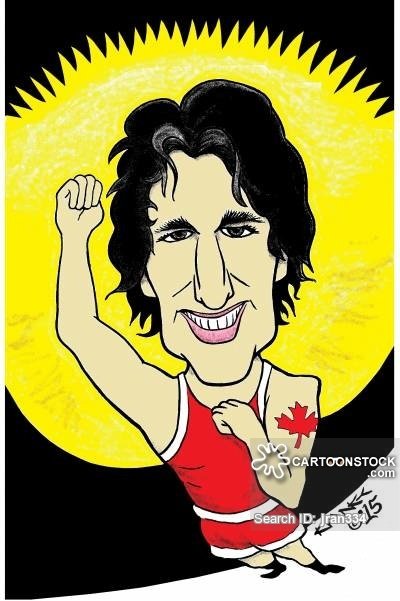
Through the microscope



1,000:
Shares at Canadian Offer
300:
400:







100
100
100
100
100
100
100
- They may not want to trade all that they post.
- will try to cancel quickly
- once their order gets hit or
- once they see trades
- => flurry of cancellations
- will try to cancel quickly
Flurry of HFT Activities after Trades
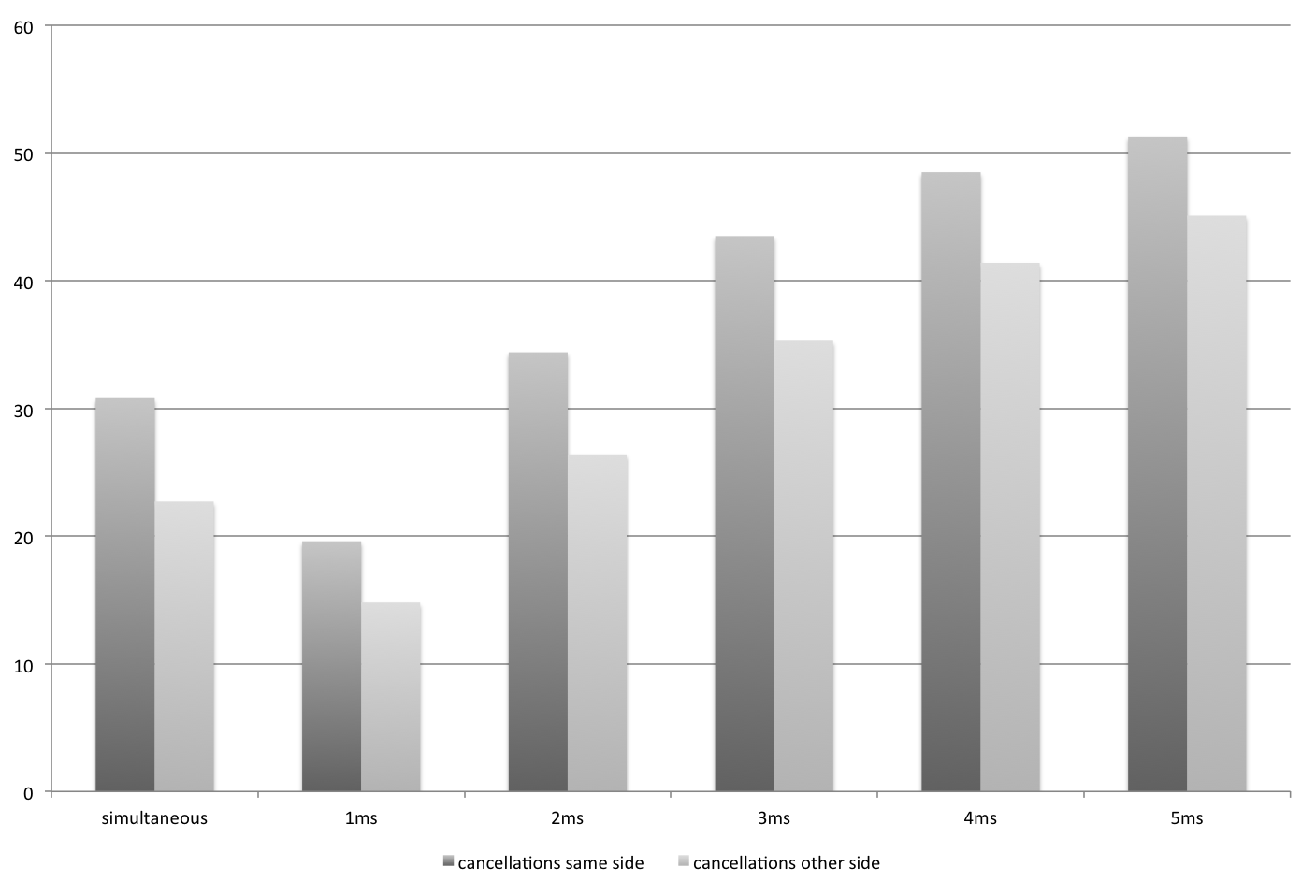
50% of trades -- by a non-HFT -- are quickly followed by a cancellation -- by an HFT -- on a different venue within 5ms of the trade
Within 50ms: about 70% of trades followed by cancels
And: the reaction is more extreme
after multi-market trades!
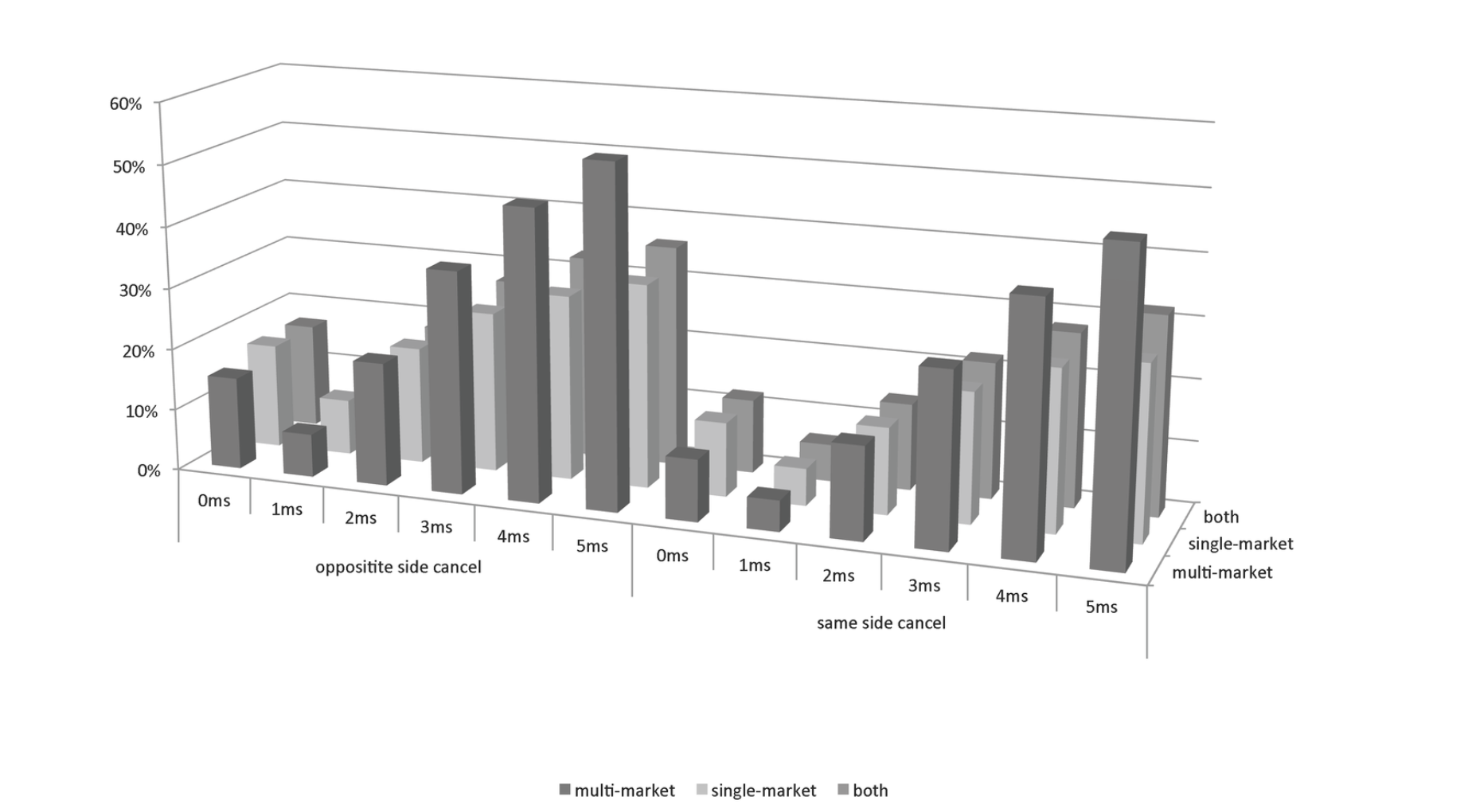
Flurry of HFT Activities after Trades
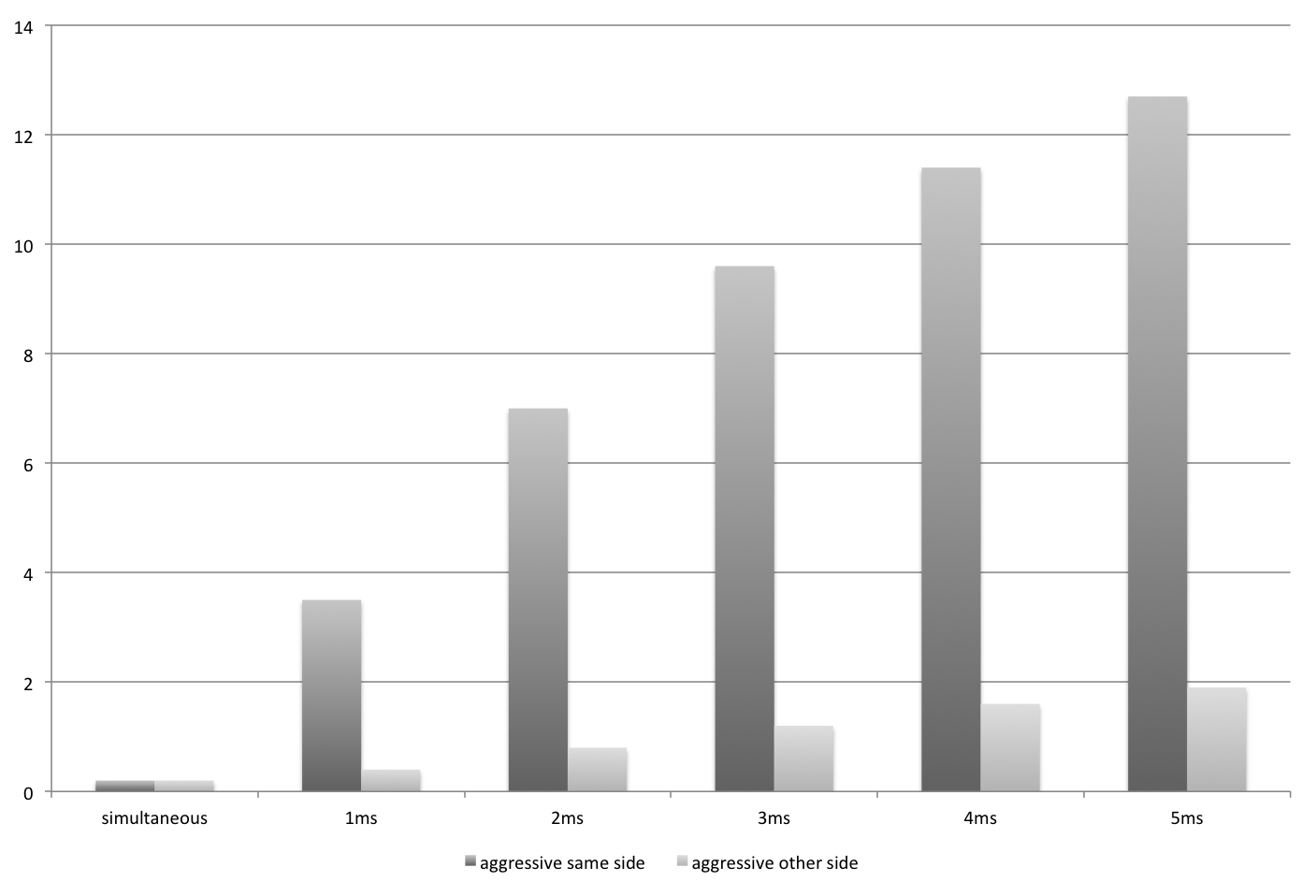
13% of trades -- by a non-HFT -- are followed by an aggressive trade -- by an HFT -- on another venue in the direction of the original trade within 5ms
Within 50ms, 29% of trades are followed
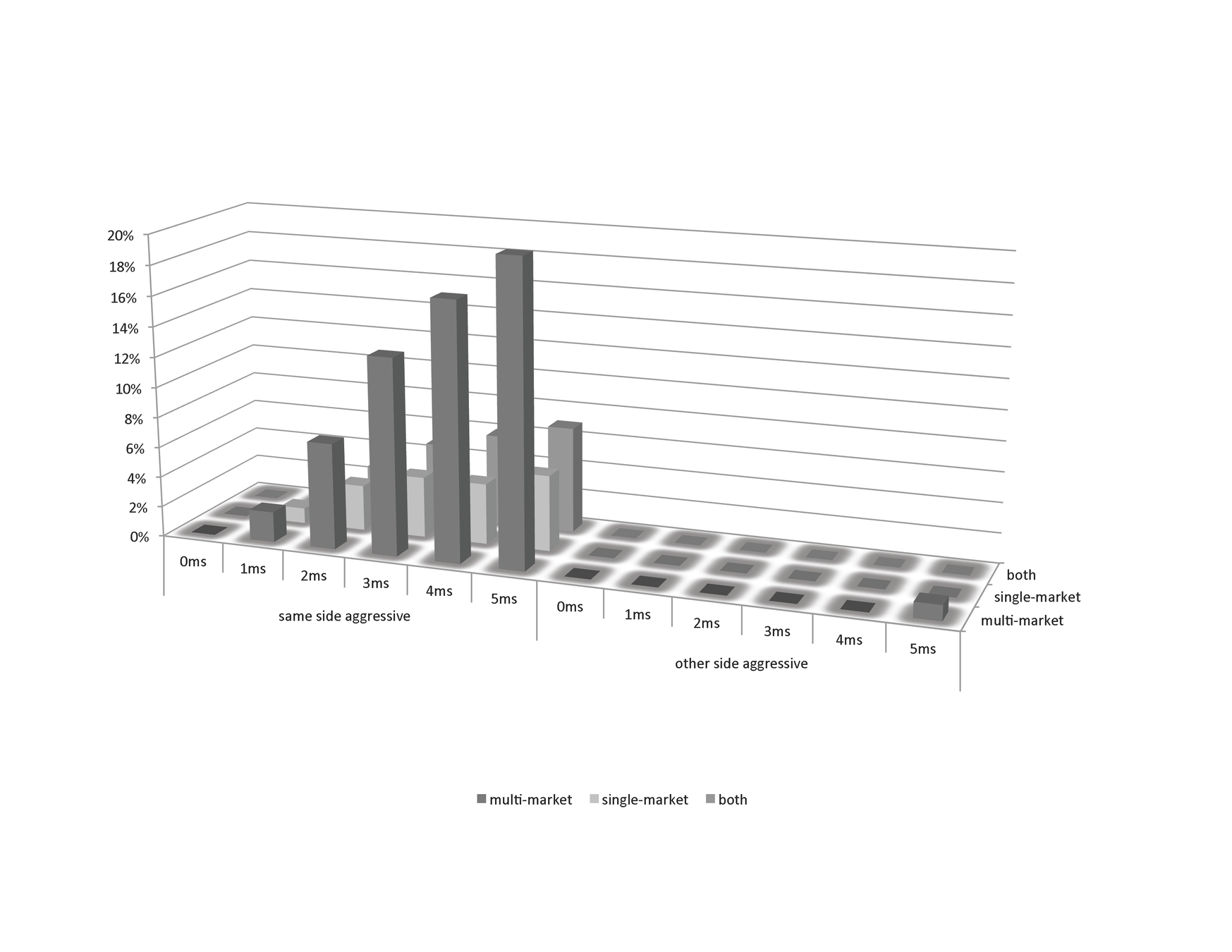
Again: the reaction is more extreme for multi-market trades!
This project's goal:
Characterize this behavior and its impact in fragmented markets
-
Step 1: Characterize/describe fast (HFT) traders’ reaction to trades:
- Do they cancel their orders? (yes)
- Do they submit own aggressive orders? (yes)
- Different reaction to single vs multi-market orders? (yes)
-
Step 2: What explains the different reaction?
-
size?
-
type of trader?
-
information?
-
- Step 3: Does the HFT behavior have an impact on the market?
Not the first to look at fragmented markets
- Long literature, including
- Joel Hasbrouck (e.g., "One Security, Many Markets: Determining the Contributions to Price Discovery", JF 1995)
- O'Hara & Ye (JFE 2011): good for mkt quality
- Degryse, de Jong, van Kervel (2014): visible vs. dark fragmentation
- Bernales, Riarte, Sagade, Valenzuela, Westhei (2017): fragmentation without competition
- most closely related:
- van Kervel (RFS 2015): over-posting exists
- Baldauf & Mollner (WP 2015) (theory): splitting of liquidity across markets
- Brogaard, Riordan, Hendershott (JF 2018): HFT generate price discovery with limit orders, without trading.
Critical Ingredients
-
Our focus:
-
HFTs in regulation-mandated integrated mkts
-
- What do we need?
- examine HFT? => need trader level info
- impact of mandated multi-mkt? => need trader level data to identify multi-mkt vs single mkt
- examine the impact => need identification
-
proprietary masked trader-level data for all Canadian equity markets (provided by IIROC, the Canadian regulator)
-
use 30 most frequently traded non-crosslisted stocks, March - May, 2013.
-
-
a critical market-organization change that eliminated latency between two of the three main markets (markets A and B) on April 29, 2013 => identification
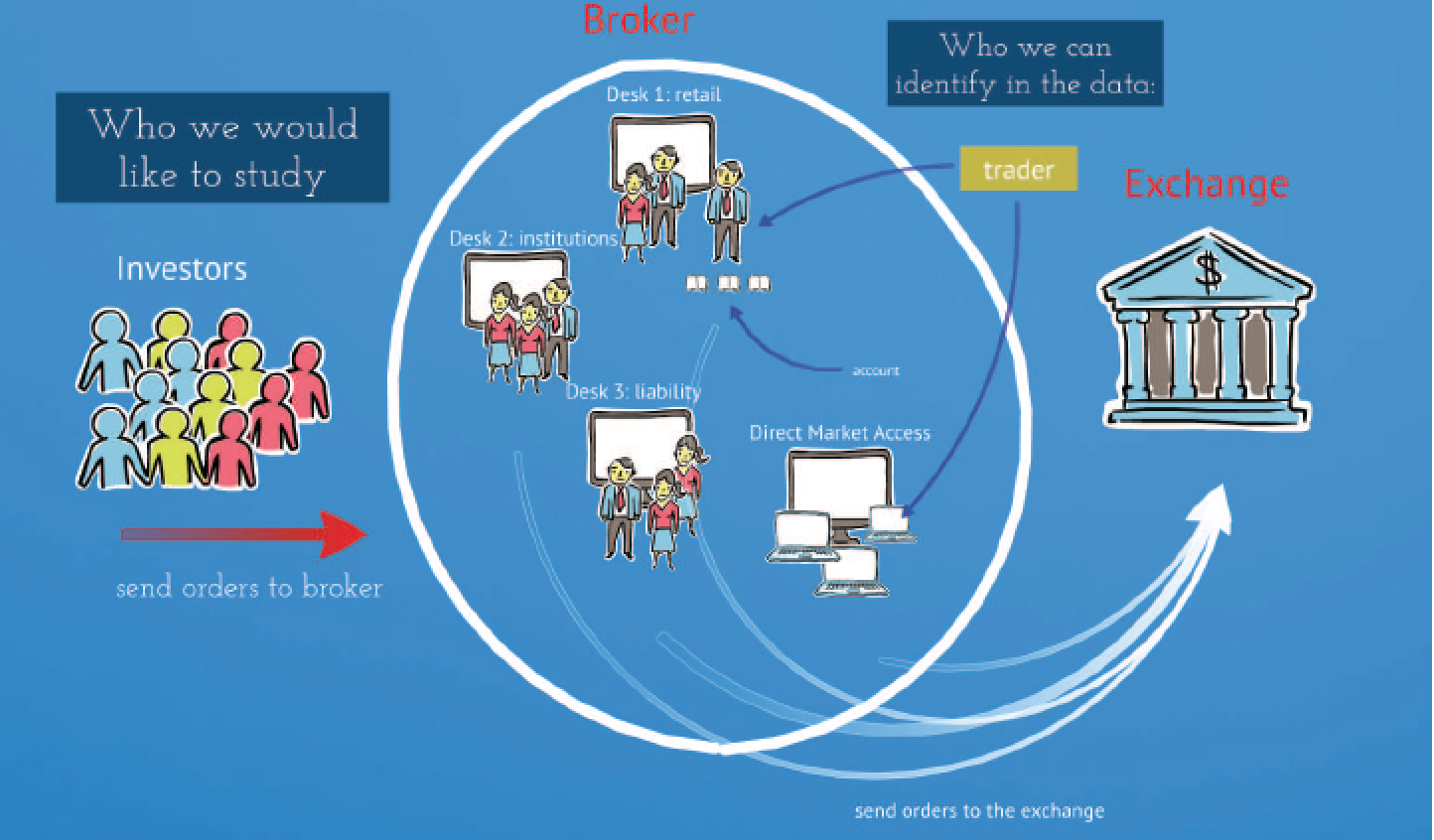
Data on Investors vs Traders
Identifying Traders
-
Similar to Comerton-Forde, Malinova, Park (2018)
-
Fast traders: Use three criteria (across many securities on many days: 307 securities, Jan& Feb, 2013)
-
regularly submit and cancel orders very quickly
-
median submit-to-cancel times < 250ms.
-
-
submit/cancel most orders very quickly subsequent to someone else’s activity
-
85% of activity within 1ms of someone else.
-
-
react quickly (500ms) to a particular, regular, market-wide news announcement (the market-on-close imbalance).
-
classified: ~82 (out of ~4,900)
-
- Retail: special order type that can only be used by retail
-
Institutions: trade-strings:
- at least 10 distinct orders
- single direction on a day
What is a multi-market trade?
-
same trader ID
- caveat: "trader ID" is not the same as "trader"
- submits marketable order on separate markets within 5 milliseconds
Post-trade Cancellation
- cancellation by fast trader
- within 1,2,...,5 milliseconds
Post-trade Aggressive Order
- in the same direction as the trade
- aggressive by fast trader
- within 1,2,...,5 milliseconds
What should we expect?
- HFT are often voluntary market makers (MMs)
- MMs don’t want to absorb large inventories because of
- capital commitments;
- risk of adverse price movements.
- MM should respond to trades.
-
post on multiple venues => cancel to avoid overtrading
-
learn new info => cancel/reprice existing quotes + "backrunning"
-
accumulate inventory => revert (=trade aggressive with trade)
-
- There is still a question if the reaction
- warranted or
- an over-reaction
- why different for multi-market
-
Trades = information.
- Baldauf and Mollner (2015): only smart trade everywhere
- van Kervel (2015): only sophisticated have access to smart order routers/multiple venues
-
Market makers post everywhere but only want to trade once.
- Cancel existing orders (van Kervel (RFS 2015))
Are multi-market trades different?
- Market making should lead to flurry of activities
- cancellations are to be expected
- aggressive orders can be part of market-making
-
Are the HFT actions merely seamlessly integrating markets?
-
First steps: are there any "in plain sight" differences between single- and multi-market orders?
- Are they submitted by more informed traders?
- Are they larger?
-
First steps: are there any "in plain sight" differences between single- and multi-market orders?
Measure of Interest: Price Impact
- signed difference of the prevailing mid-point of the NBBO bid-ask spread \(\tau\) time units in the future and the mid-point that prevailed at the time of the trade

- \(q_{it}\) = 1 for buyer-initiated and -1 for sells
- \(m_{it}\) = midpoint at time t
Are multi-market trades more informed?
Simple summary stat: price impact
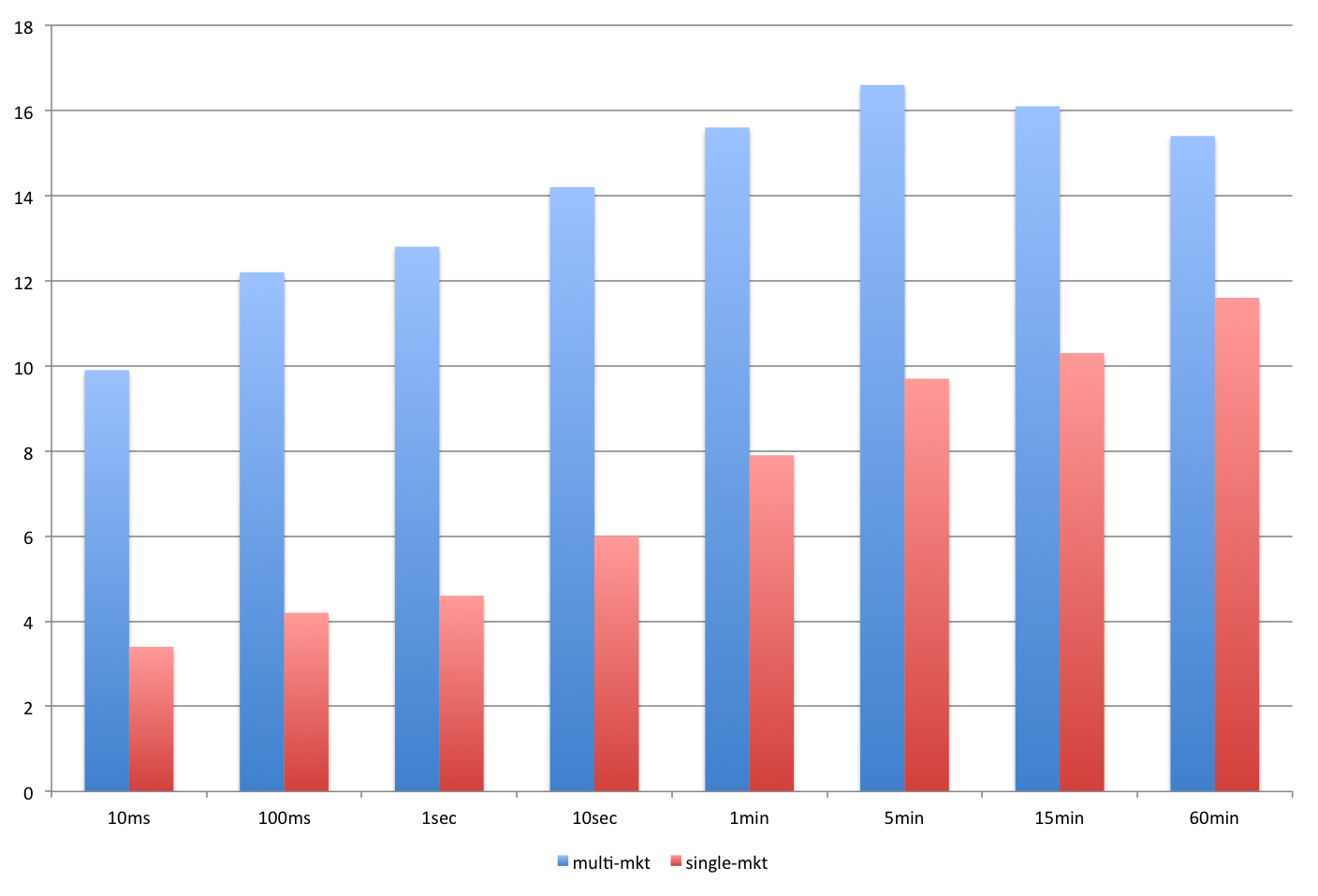
Naive conclusion: multi-market trades have higher price impact, therefore they are more informed
Consistent with Baldauf & Mollner and van Kervel:
multi-market = smarter
HFTs must react stronger!
End of story?
Who trades in multiple markets?
All trades
Multi-market trades
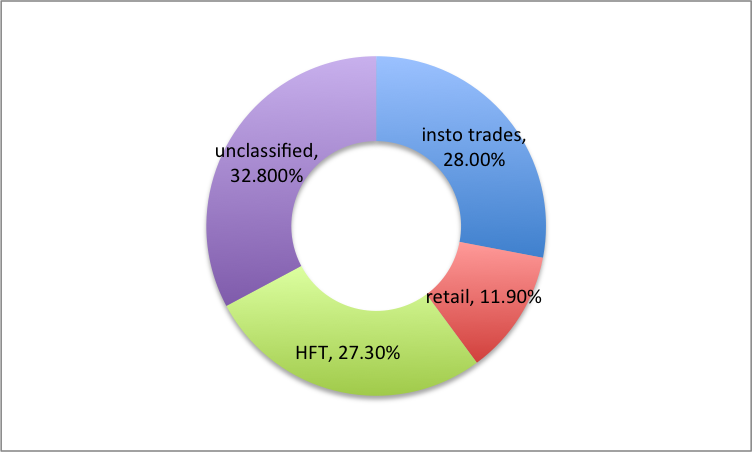
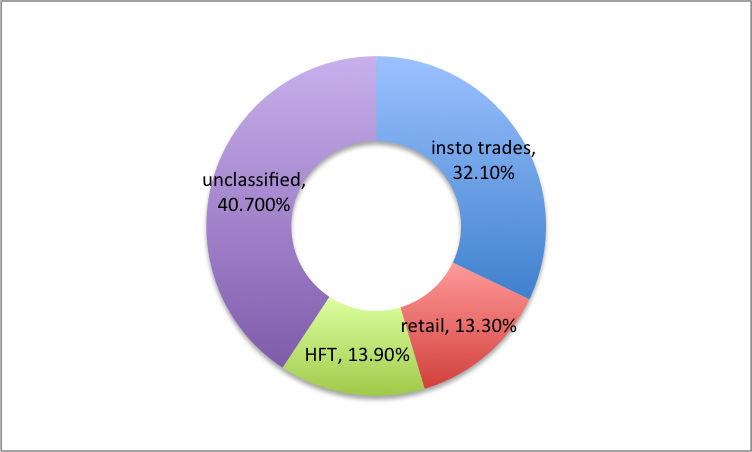
Multi-market trades:
\(\approx\) 32% of total $-value
Price impact for retail trades
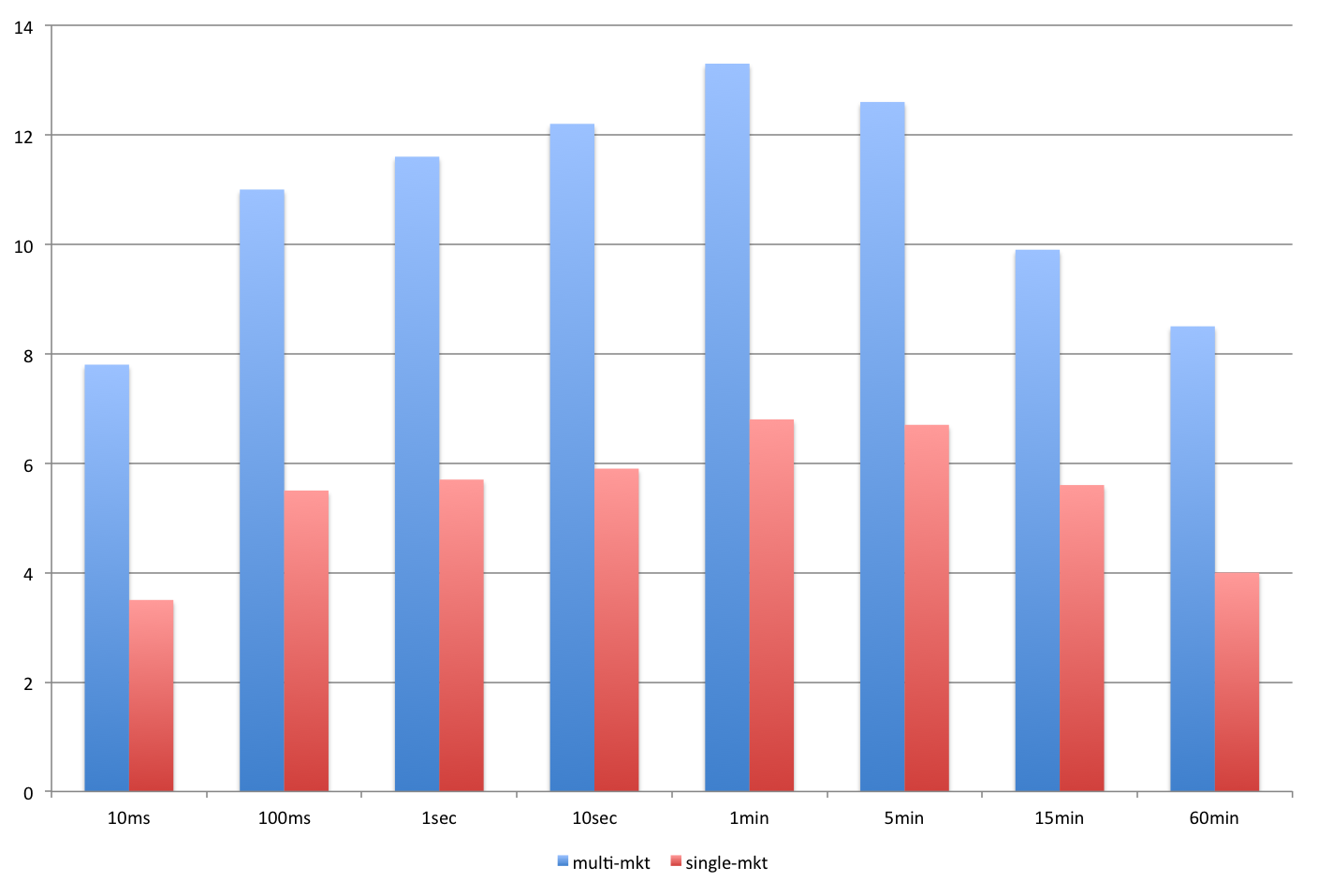
Conclusion: If we believe that retail orders are not informed, then the price impacts for single vs. multi-market orders shouldn't look this different.
Reminder:
- Broker SORs may have to split larger orders to obey OPR
- Brokers may want to split larger orders to avoid high costs
Multi-Market
Single Market
vs.
Is it Size?
| trade size | % of all value | % of multimarket value |
|---|---|---|
| 100-200 | 23 | 3 |
| 201-500 | 17 | 11 |
| 501-1,000 | 15 | 15 |
| 1,001 -- 5,000 | 25 | 36 |
| >5,000 | 19 | 36 |
$ value of trades per bucket
$ value of all trades
$ value of multi-mkt trades per bucket
$ value of all multi-mkt trades
Size distribution
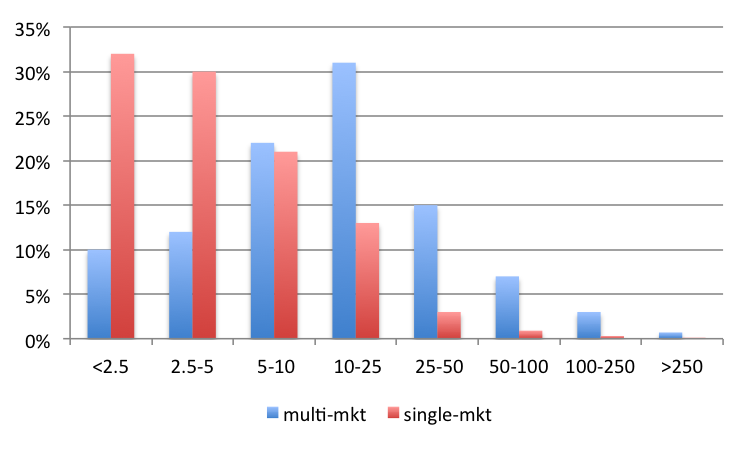
Conclusion: multi-mkt orders are larger
Is it size?
Single Market
Multi-Market
Larger size => larger price impact?
Plotting: price impact multi-mkt minus single-mkt
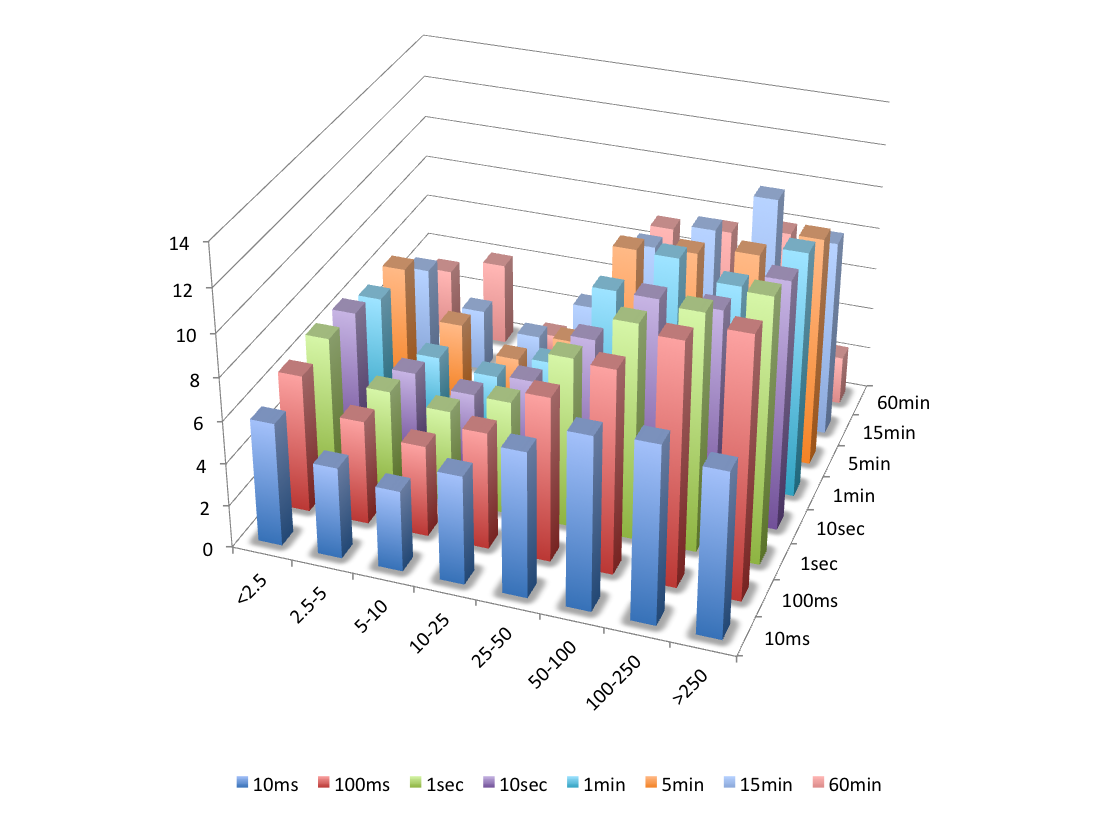
Conclusion: even for similar size, price impact of multi-market orders is larger.
Is it size?
Could price impact be larger because of the HFT reaction?
Plotting: price impact with HFT reaction minus price impact without HFT reaction
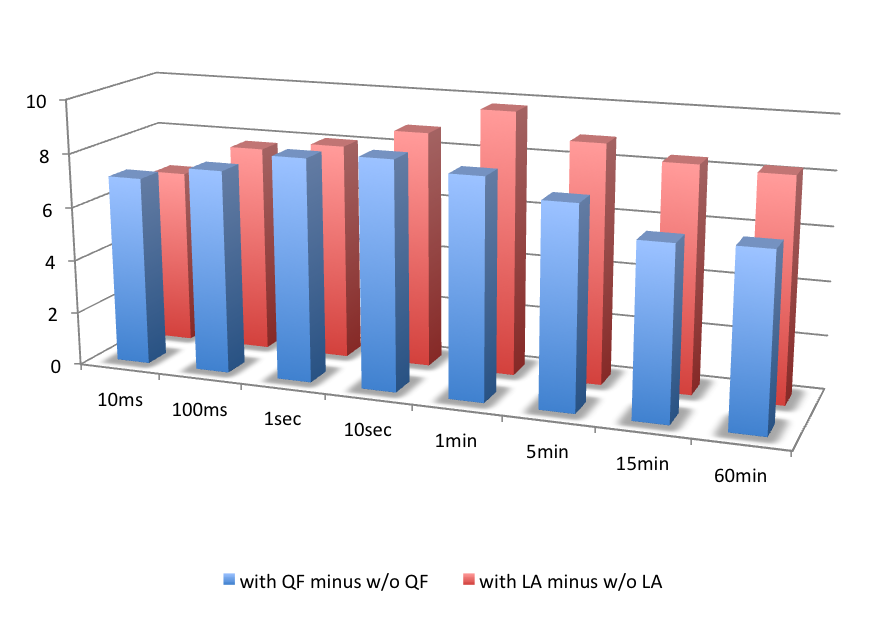
reaction = cancellations
Reaction= trades
Observation: HFT makes your trade look fat
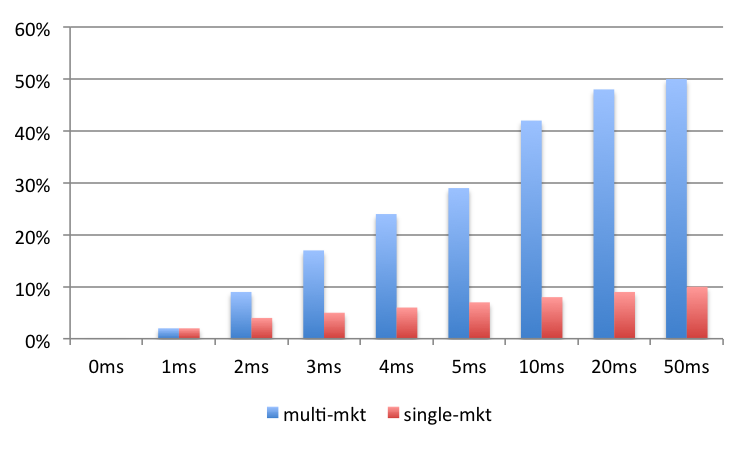
fast aggressive orders(same direction minus opposite direction)
total number of transactions
Conclusion: HFT reaction looks like there is much more activity than warranted by the original trade
Multi-Market
Single Market
Bottom Line
- multi-mkt trades are larger but need not be smarter
- using multi-mkt is/can be regulation requirement
- possibly exchange fee considerations
- retail (brokers) use them regularly
- multi-mkt have larger price impact
- even for retail
- for same size
- multi-mkt with HFT cancellations/aggressive submissions
- have larger price impacts.
- look "bigger"
"Trade clusters"
- "Merge" all transactions that occur within a short (10ms) time interval into a "trade cluster", instead of restricting these to be by a single trader
- Average cluster lasts for 3.4ms
- Compare trade clusters :
- with single vs. multiple traders (i.e., where the original trade was followed by others)
- that occur on a single vs. multiple markets
Price Impact of Trade clusters
- Assign all trade clusters into one of the four categories:

| Single Trader | Multi Trader | |
| Single Mkt | ||
| Multi Mkt |
- Estimate a regression over all trades to assess whether following by other other traders & multi-market trading matters for the price impact, controlling for the size
Price Impact in Trade Clusters
| Dummy | Coeff controlling for the vol of the first trade | Coeff controlling for the aggregate cluster volume |
|---|---|---|
| MultiMkt-SingleTrader | 0.645*** | 0.605*** |
| SingleMkt-MultiTrader | 1.919*** | 1.132*** |
| MultiMkt-MultiTrader | 2.095*** | 1.137*** |
- Effects on the price impact 5ms after the trade (in basis points), controlling for the size of the first trade in a cluster or for the aggregate volume of the trade cluster (2 separate regressions):
Who follows the trades and why?
- Over 60% of follow-up trades stem from 14 fast traders
- As a group, these:
- Earn $1.25M on in-cluster trades
- Lose $0.28M on out-of-cluster (active) trades
- Compute return per trade, relative to the trade's VWAP and assuming that positions are closed at end-day prices:

- Estimate:

Who follows the trades and why?
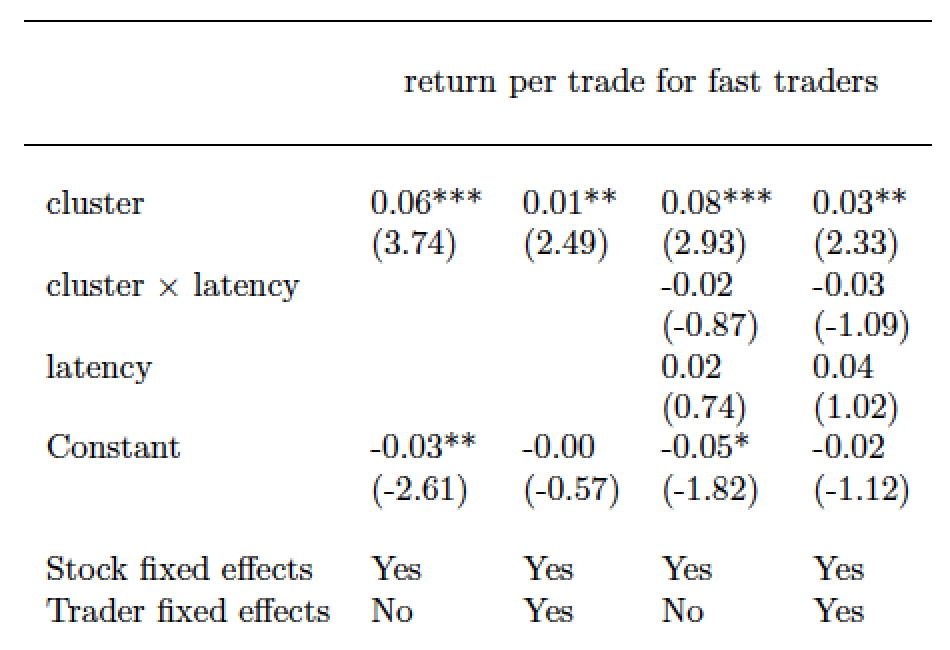
Bottom Line
- Price Impacts are higher for
- Trades that execute on multiple markets -- even after controlling for trade size
- Possible explanations: liquidity effects: the choice of whether to go to multiple markets is endogenous
- Trades that are followed by other traders -- again, after controlling for trade size
- This latter effect is even more pronounced for trades that are followed by one of the 14 fast traders
- Trades that execute on multiple markets -- even after controlling for trade size
- Remains unresolved whether followers:
- increase the price impact by making trades look "bigger"
- or follow the trades that are informed ("back running")
The Big Question
-
Is the reaction:
- reacting to information/price discovery
- HFT push prices to the "right" level
- or noise
- HFT reaction obfuscates learning
- reacting to information/price discovery
How to identify?
- Idea: if latency between venues disappears:
- non-HFT order flow should remain similar
- if price discovery => HFT can create same level of it.
- "Following" is harder to implement:
- if noise => lower price impacts
- non-HFT order flow should remain similar
How do you make physical latency disappear?
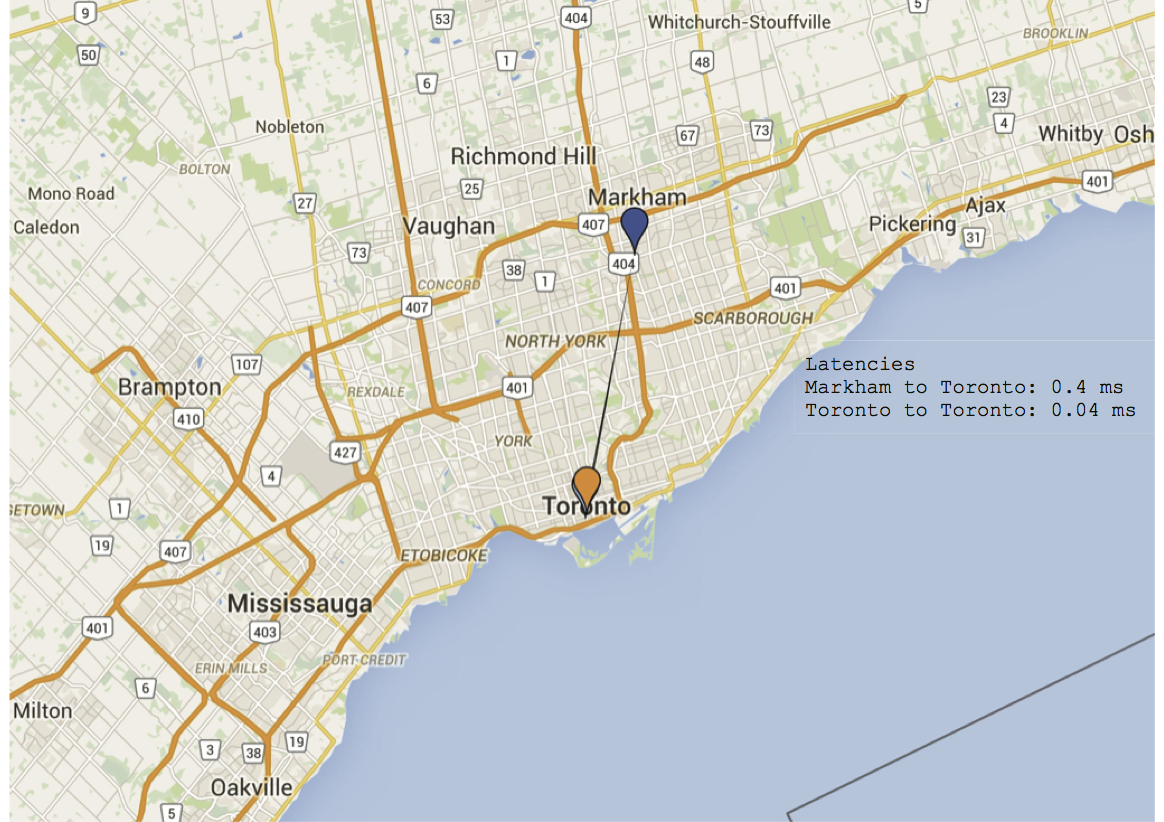
Market A and B move to the same data centre: April 29, 2013
What would we expect?
- if you post on both A and B, you cannot avoid being "hit" on both, i.e. no more outrunning
- depth should decline
- spreads may increase
- fewer post-trade cancellations
- impact on post-trade aggressive trading is unclear
- Notable differences between A and B:
- Market A: lowest take fee/make rebate
- Market B: "big", highest take fee/make rebate
Empirical Strategy
Examine changes in market quality and trader behavior
- before/after (March 1-May 31) and also by market;

- DV dependent variable of interest
- Dummies for the event and the market
- Controls include VIX for volatility & an ETF for the S&P500 GSCI commodity index for the price level
- Security and mkt fixed effects
- Std errors double-clustered by date and security
Changes in Liquidity and fast trading activities

Changes in Responses to Trades
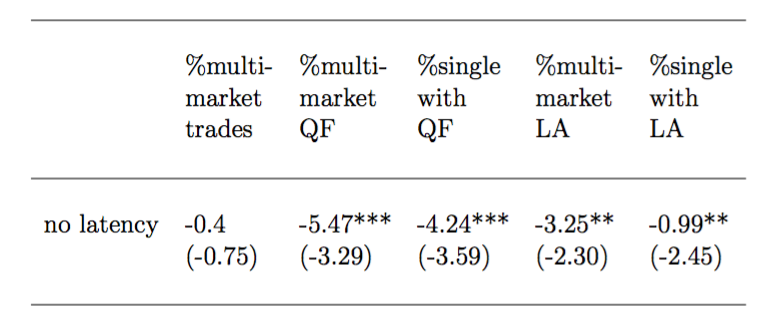
(no)
Untabulated: no significant changes in size or usage of multi-mkt trades
Changes in Price Impacts
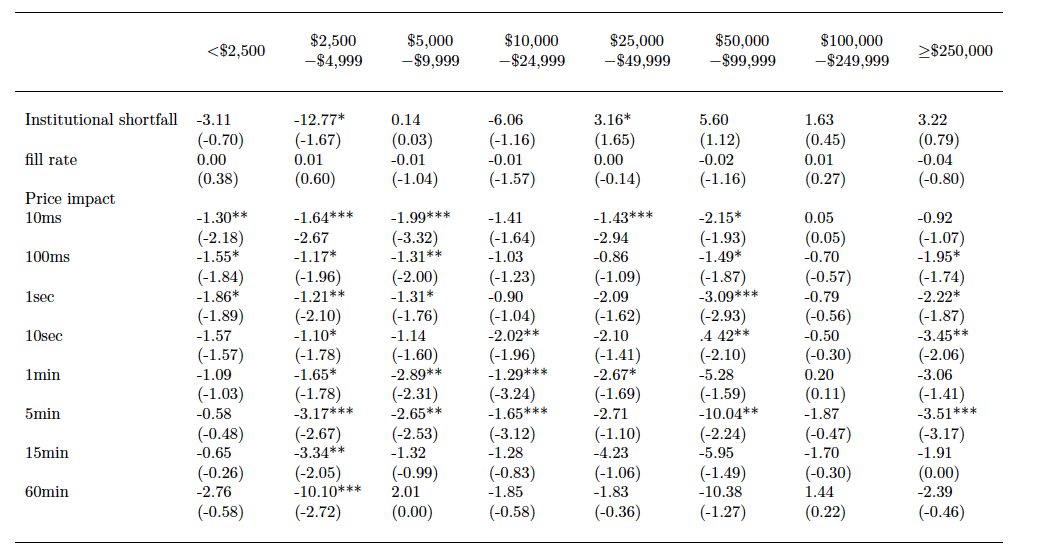
Bottom line: price impacts of multi-market orders decline
Difference in differences of multi- vs. single-mkt orders before vs after
Summary and Conclusion
- Multi-market trades are
- common
- often required by regulation
- also performed by choice (and without need?)
- not the sole purview of sophisticated traders
- How do fast traders react to trades?
- Fast traders cancel quotes rapidly and take out (stale?) quotes after trades.
- Stronger reactions to multi-market trades
-
What does HFT behavior do?
- Some evidence that it increases price impact of orders
- indication that in multiple mkts, HFT may obfuscate learning/price discovery
- Some evidence that it increases price impact of orders